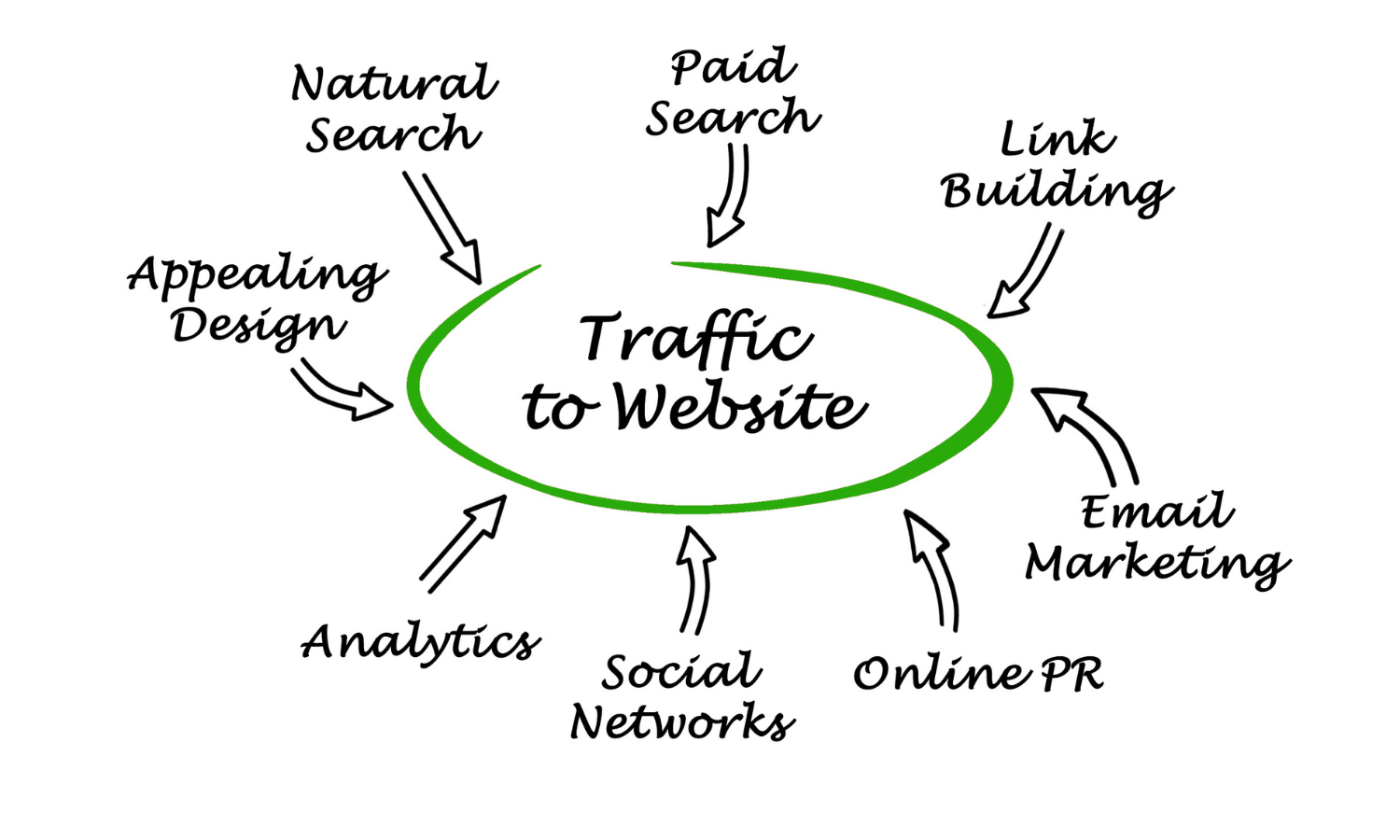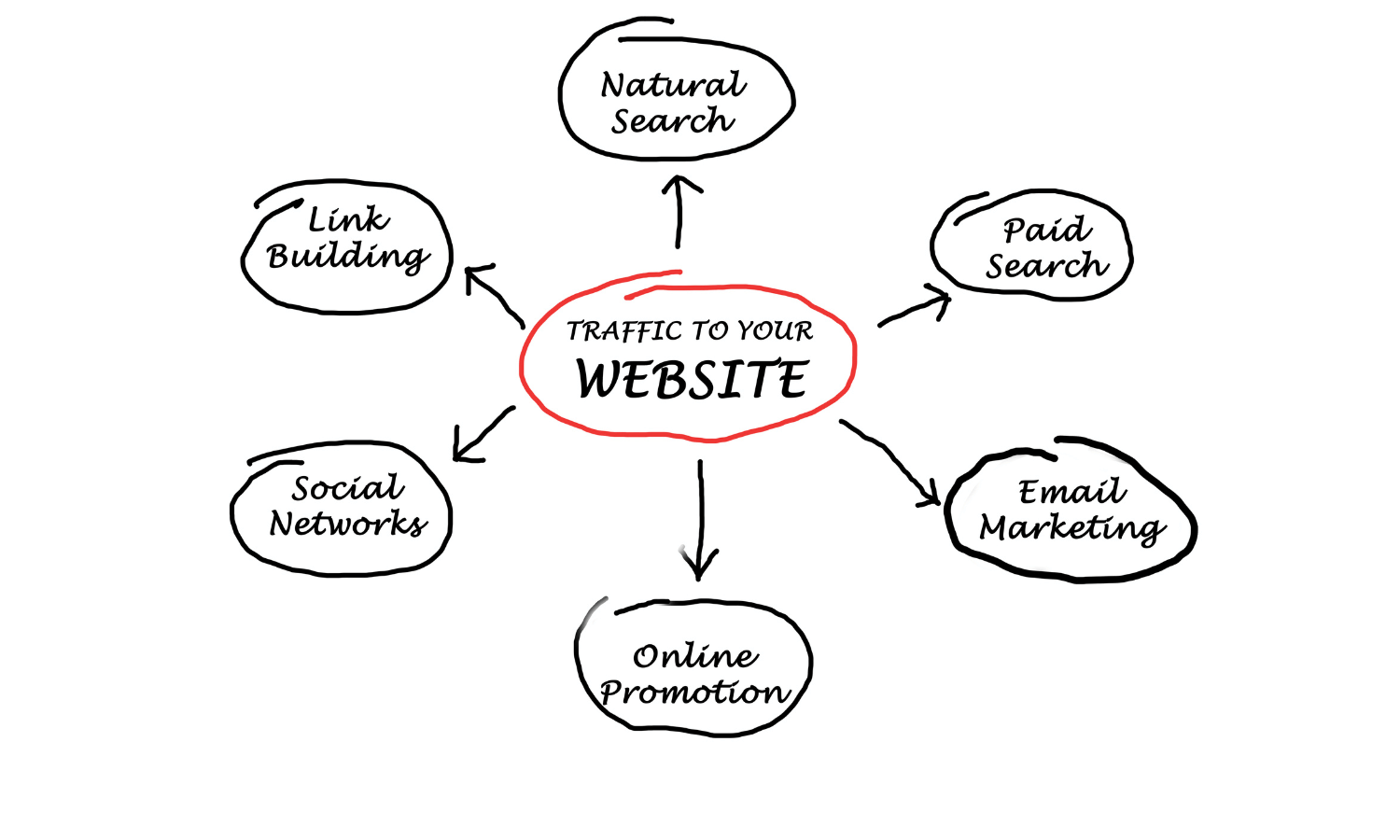Introduction
In the vast landscape of the digital realm, web traffic serves as the lifeblood that powers online success. Every click, every visit, and every interaction holds the potential to propel businesses, brands, and content toward unprecedented heights. As the digital marketplace becomes increasingly competitive, understanding the nuances of web traffic sources becomes essential for those seeking to thrive in this dynamic ecosystem.
In this article, we delve into the intriguing world of web traffic, with a specific focus on the intriguing interplay between two major traffic sources: organic and direct. While both pathways bring users to your virtual doorstep, they bear distinct characteristics that shape user intent, engagement, and ultimately, your online outcomes. Our aim is to equip you with a comprehensive understanding of these traffic sources, empowering you to make informed decisions that drive your digital strategy forward.
Throughout the following sections, we will demystify the essence of organic and direct traffic, unravel their key differences, and unveil the factors that influence their trajectories. From insights into user behaviour to the technical underpinnings that guide their paths, we’re here to shed light on how these traffic sources can impact your online endeavours. Whether you’re an entrepreneur, a marketer, or an enthusiast keen to grasp the intricacies of web traffic, this article has something valuable in store for you.
So, fasten your seatbelt as we embark on a journey to decipher the complexities of web traffic, exploring the nuanced dynamics between organic and direct sources. By the end of this expedition, you’ll be equipped with the knowledge to harness the power of both traffic types, steering your digital presence toward the shores of success. Let’s begin our exploration of the fascinating world of web traffic and discover how it can shape your online destiny.

Exploring Organic Web Traffic Dynamics
At the heart of the digital landscape lies organic traffic, a pivotal force that carries users to websites through genuine, non-paid interactions. Organic traffic originates primarily from search engines, with users discovering websites through unpaid search results. Unlike paid advertising, organic traffic doesn’t involve direct monetary investments for placement, making it a natural and authentic pathway for users to explore content, products, and services.
The benefits of organic traffic extend far beyond mere clicks and visits. Organic traffic showcases a unique form of user intent, reflecting individuals actively seeking relevant information or solutions. This intent-driven approach brings highly targeted visitors to your website, increasing the likelihood of meaningful engagement, conversions, and long-term customer relationships. Furthermore, organic traffic is a source of sustainable growth, as it continues to yield results even when advertising budgets may be constrained.
Central to the realm of organic traffic is the practice of search engine optimization (SEO). By strategically optimizing website content, structure, and technical aspects, businesses can enhance their visibility in search engine rankings. This results in increased organic traffic, driven by the alignment of user queries with your content offerings. Effective SEO empowers your website to earn its place in top search results, positioning you as a trusted authority within your industry or niche.
Statistics and trends further underscore the significance of organic traffic. Studies consistently reveal that organic search remains a dominant source of website visits, often surpassing other traffic channels. This reaffirms the enduring relevance of organic traffic in the ever-evolving digital landscape. By understanding the intricacies of organic traffic and harnessing the power of SEO, businesses can tap into a sustainable flow of engaged users, fostering growth, and achieving digital success.
Diving Deeper into Direct Traffic
Direct traffic constitutes visits to your website that occur when users directly enter your website URL into their browser, use bookmarks, or access untracked sources. Unlike organic or referral traffic, direct traffic doesn’t come through search engines or external links. Instead, it’s a direct interaction between users and your website. This type of traffic can be a mix of both new and returning visitors, including those who are already familiar with your brand and choose to visit your site directly.
Characterized by its immediacy and direct connection, direct traffic often consists of users who have a specific intention to reach your website. They might be loyal customers who have your website saved as a bookmark, or individuals who have memorized your URL. Due to this direct nature, direct traffic can be a valuable source of engaged visitors who are likely to interact with your content or convert.
However, measuring direct traffic accurately can be a challenge. While some instances, like users typing in your URL, are easily identifiable, there can be cases where the source of the visit remains untracked. For instance, if someone clicks on a link in an untracked PDF document or accesses your site through a secure HTTPS connection, it might register as direct traffic even if there was an indirect source. This variation in tracking can make it complex to attribute specific sources to direct traffic accurately.
Common scenarios that contribute to direct traffic include users who have your website bookmarked for frequent access, those who access your site through offline channels like printed materials, or visitors who manually enter your URL after hearing about your brand through word-of-mouth. Direct traffic often represents a blend of intentional interactions and users who have established a connection with your brand over time.
Key Differences Between Organic and Direct Traffic
When it comes to web traffic, understanding the dynamics of organic and direct traffic is pivotal for your online success. These two distinct sources bring visitors to your website, each with its own characteristics and implications. Let’s delve into the key differences between organic and direct traffic to help you navigate this essential aspect of your online presence.
Intent-Driven vs. Familiar Visitors
Organic traffic primarily consists of users who arrive at your website through search engines. These visitors are actively seeking information, products, or services related to your content. On the other hand, direct traffic is composed of those who are already familiar with your brand or have your website URL bookmarked. They directly type your URL or access it from their bookmarks, reflecting a pre-existing awareness of your site.
Search Engine Influence and Broader Reach
Organic traffic owes its existence to search engines. Users enter relevant keywords, and search engines present your site as a potential solution. This grants organic traffic a wider reach, tapping into users actively looking for what you offer. On the contrary, direct traffic sources are more limited, stemming from returning visitors or those who directly access your site.
User Intent and Conversion Potential
Organic traffic‘s hallmark is user intent. Visitors arrive with a specific purpose, making them more likely to engage with your content, explore your offerings, and convert into customers. This heightened user intent often translates into higher conversion rates, as these users are more likely to take desired actions. Direct traffic, while familiar with your brand, might not always exhibit the same level of intent, leading to potentially varied engagement levels.
Dependence and Potential Volatility
Organic traffic is influenced by your website’s search engine rankings and SEO efforts. While it might require ongoing optimization, it offers a level of stability. In contrast, direct traffic can be influenced by external factors such as offline promotions, brand recognition, or word-of-mouth. This can lead to variations in direct traffic levels, making it somewhat more susceptible to changes beyond your online control.
Understanding these key differences between organic and direct traffic provides valuable insights into user behaviour and how your website is perceived. By harnessing the strengths of both types of traffic, you can create a well-rounded online strategy that caters to a diverse audience and optimizes your conversion potential.

Influencing the Flow: Factors Affecting Organic and Direct Traffic
The ebb and flow of web traffic are influenced by a multitude of factors, shaping the dynamics of both organic and direct traffic. Understanding these factors is essential for optimizing your online presence and crafting effective strategies. Let’s explore the distinct elements that impact both types of traffic.
Organic Traffic and its Drivers
Organic traffic‘s lifeblood is search engine optimization (SEO). Your website’s ranking on search engine results pages greatly affects the volume of organic visitors. Effective keyword research, relevant content creation, and technical optimization are pivotal in attracting users actively searching for solutions your website offers. Regular algorithm updates from search engines can also sway organic traffic trends, making it crucial to stay informed and adaptable.
Direct Traffic and the Power of Branding
Direct traffic often finds its roots in branding efforts and offline promotions. A strong brand presence encourages users to directly type your URL, reflecting familiarity and trust. Offline marketing initiatives, like radio ads or print media, can drive users to remember your website and access it directly. Additionally, word-of-mouth referrals and social media buzz contribute to direct traffic, showcasing the power of a recognizable brand.
Offline Promotions and User Behavior
While organic traffic relies heavily on online strategies, direct traffic can be significantly influenced by offline initiatives. Hosting local events, participating in community activities, and networking can all funnel users to directly access your site. Moreover, user behaviour plays a role in direct traffic. Returning visitors, loyal customers, and those who’ve bookmarked your site contribute to the consistent flow of direct traffic.
Varied Impacts and Unified Strategy
Understanding these factors empowers you to tailor your strategies for both types of traffic. Enhancing your website’s SEO and content quality boosts organic traffic while investing in branding and offline promotions bolsters direct traffic. By developing a unified strategy that leverages the strengths of each traffic source, you can create a comprehensive online presence that resonates with a diverse audience and maximizes your web traffic potential.
Benefits and Limitations of Organic and Direct Traffic
In the bustling landscape of web traffic, both organic and direct sources bring their distinct benefits and limitations. Recognizing these aspects provides a deeper understanding of how to harness their potential effectively. Let’s delve into the advantages and constraints of each type of traffic.
Advantages of Organic Traffic: Targeted Audience and Longevity
Organic traffic shines with its ability to attract a highly targeted audience. Users arriving through organic search results are actively seeking specific information, products, or services that your website offers. This intent-driven nature leads to higher chances of conversions and engagement. Additionally, organic traffic’s foundation lies in SEO, which, when executed strategically, can yield long-term benefits. A well-optimized site can maintain its position in search results, providing a steady stream of relevant visitors.
Advantages of Direct Traffic: Brand Familiarity and Trust
Direct traffic‘s strong suit lies in brand recognition and trust. Users accessing your website directly are often familiar with your brand and have prior knowledge or positive experiences. This familiarity instills a level of trust, leading to increased engagement and potentially higher conversion rates. Furthermore, direct traffic can serve as a gauge of your brand’s overall strength, reflecting customer loyalty and the impact of offline marketing efforts.
Limitations of Organic Traffic: SEO Fluctuations and Algorithm Changes
Organic traffic‘s Achilles’ heel lies in its susceptibility to SEO fluctuations and algorithm changes. Search engine algorithms evolve, and shifts in rankings can impact your organic traffic volume. Staying at the top requires ongoing SEO efforts and adaptation to algorithm updates. While organic traffic can be a consistent source, its stability may be affected by these variables.
Limitations of Direct Traffic: Dependency on Brand Recognition
Direct traffic‘s reliance on brand recognition poses a challenge. While loyal customers and direct visits are valuable, the growth potential hinges on your brand’s visibility. If brand awareness is limited, scaling direct traffic might be challenging. Relying solely on direct traffic can also lead to missed opportunities from potential users who are yet to discover your brand.
Balancing the Scales: Strategic Approach
Understanding these advantages and limitations is pivotal in developing a balanced web traffic strategy. Leveraging organic traffic’s intent-driven audience and direct traffic’s brand trust requires a comprehensive approach. By utilizing the strengths of both sources while mitigating their respective shortcomings, you can create a well-rounded online presence that resonates with diverse audiences and drives sustainable growth.

Maximizing Gains from Organic and Direct Traffic
In the dynamic realm of web traffic, wise navigation involves harnessing the potentials of both organic and direct sources to your advantage. Let’s delve into strategic insights on optimizing each traffic stream for optimal results.
Amplifying Organic Traffic: SEO Optimization and Compelling Content
To bolster organic traffic, a strong SEO foundation is key. Start by conducting thorough keyword research to understand user intent and preferences. Craft high-quality, relevant content that addresses these user needs, incorporating target keywords naturally. Regularly update and optimize your existing content to align with search engine algorithms.
Invest in on-page optimization, refining meta tags, headings, and internal linking structures. Additionally, focus on building authoritative backlinks from reputable sources within your industry. Utilize analytics tools to track performance, identify trends, and adjust your strategies accordingly. By staying attuned to SEO best practices and continuously refining your content, you can elevate your organic traffic game.
Strengthening Direct Traffic: Enhancing Brand Recognition and Engagement
To enhance direct traffic, emphasize brand recognition and engagement. Consistency across branding elements, such as logos, colours, and messaging, fosters a memorable brand identity. Leverage social media platforms and email marketing to keep your audience engaged and informed about your offerings.
Encourage repeat direct traffic by offering incentives, exclusive content, or loyalty programs. Provide valuable resources on your website that cater to your target audience’s interests and needs. Implement clear and user-friendly navigation, ensuring that visitors can easily find what they’re looking for. By fostering a strong brand connection and providing valuable content, you can cultivate a loyal base of repeat visitors.
Balancing Act: Synergy between Organic and Direct
The magic lies in the synergy between these two traffic sources. Organic traffic casts a wide net by reaching users actively searching for solutions, while direct traffic leverages brand familiarity and loyalty. Cross-promotion is a valuable tactic—optimize your content for search engines to capture organic traffic while incorporating CTAs and links that encourage direct visits.
Striking this balance requires a holistic approach that embraces both sources’ strengths. Regularly analyze your traffic sources’ performance and adjust your strategies accordingly. By capitalizing on the unique advantages of each source while strategically interweaving them, you can drive meaningful growth, engagement, and conversions on your digital journey.
Analyzing Organic and Direct Channels
In the intricate web of online analytics, deciphering the nuances between organic and direct traffic channels is a vital skill. Unravel the mysteries of user behaviour and make well-informed decisions with precise tracking insights.
Analyzing Organic vs. Direct Traffic: Web Analytics Tools Unveiled
Web analytics tools serve as your compass in the vast digital landscape. Google Analytics, for instance, allows you to differentiate between organic and direct traffic sources. Organic traffic originates from search engines, presenting users actively seeking your content. Direct traffic, on the other hand, consists of users directly typing your URL, clicking bookmarks, or arriving from untracked sources.
By segmenting these sources in analytics tools, you gain clear visibility into the pathways users take to reach your website. Distinguish between intentional searches and brand enthusiasts who know your URL by heart. Accurate tracking empowers you to comprehend user preferences and tailor your strategies accordingly.
Empowering Decision-Making: The Significance of Accurate Tracking
Accurate tracking isn’t just a fancy number game—it’s a powerful tool for understanding your audience. With precise data, you can identify which content resonates with organic traffic and which campaigns ignite spikes in direct visits. This insight guides your content creation, marketing campaigns, and user experience enhancements.
Pinpoint high-performing keywords that drive organic traffic, and optimize your content further to amplify these results. Understand the pages that attract direct visitors, and fine-tune them to enhance engagement. Data-driven decisions are the bedrock of your online success—unlock the potential to tailor your strategies and provide value to your audience.
Gaining the Competitive Edge: Leveraging Analytics
Every click, every visit, and every interaction holds a piece of the puzzle. Embrace the power of web analytics to differentiate between organic and direct traffic. Dive into user demographics, behaviour flows, and engagement metrics to create a comprehensive picture of your audience’s journey.
As you align your strategies with data-backed insights, you unlock the competitive edge to surpass your goals. The digital realm is dynamic—stay vigilant and responsive to shifts in trends, preferences, and user expectations. By harnessing the capabilities of web analytics, you’ll not only comprehend the landscape but navigate it strategically to elevate your online presence.
Conclusion
In the journey of unravelling the intricacies of web traffic, you’ve gained valuable insights into the realms of organic and direct channels. Let’s recap the key takeaways that will empower your digital endeavours.
A Holistic Web Strategy: The Sum of Its Parts
As we conclude this exploration, remember that both organic and direct traffic play pivotal roles in your web strategy. Organic traffic brings intent-driven visitors seeking relevant content, while direct traffic represents the familiar faces drawn to your brand. Balancing these channels is essential for a well-rounded online presence.
Your Roadmap to Enhanced Web Traffic
As you tread the digital landscape, armed with newfound knowledge, apply these insights to your advantage. Optimize your content and SEO practices to captivate organic traffic. Strengthen your brand’s recognition to foster repeat direct visitors. By weaving these strategies together, you’ll unlock a symphony of web traffic that resonates with your audience.
Forge Ahead: Unleash the Power of Web Traffic
Don’t let these insights gather dust. Implement them to refine your digital strategies and lead your website to greater heights. Stay attuned to the evolving landscape, remain responsive to user behaviour, and adapt your approaches accordingly. The world of web traffic is ever-evolving, and with each decision, you shape your online destiny.
Empower your web journey with the wisdom acquired here. Seamlessly traverse between organic and direct traffic, leveraging their unique strengths. Unleash the full potential of your online presence, crafting a symphony of engagement, conversion, and success. Your website is your canvas—paint it with the vibrant hues of balanced web traffic strategies.

Ready to Elevate Your Web Traffic Strategy?
If you’re eager to transform your web traffic landscape and propel your online presence to new heights, look no further. Explore our range of services and resources dedicated to SEO and web traffic optimization. Whether you’re a seasoned navigator of the digital realm or just setting sail, our expertise can guide you toward unlocking the full potential of your website. Delve into the world of targeted traffic, impactful content, and strategic insights. Navigate to our SEO services page to discover how we can help you chart a course to digital success.
